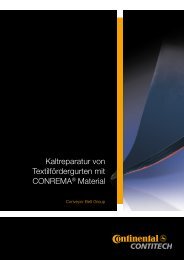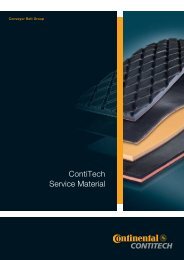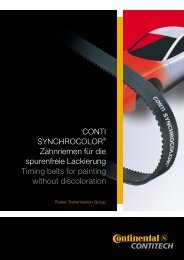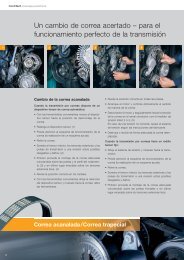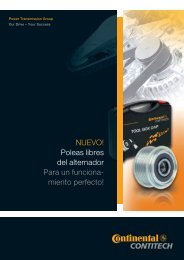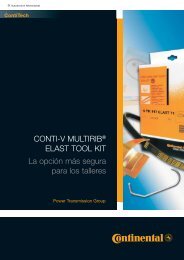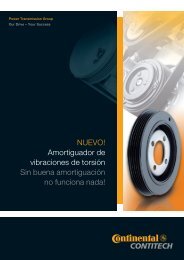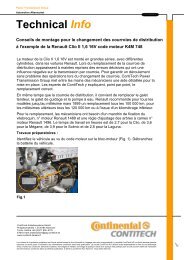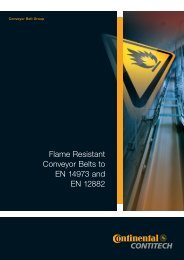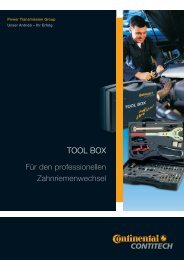Technical Info 1-25 - ContiTech AG
Technical Info 1-25 - ContiTech AG
Technical Info 1-25 - ContiTech AG
You also want an ePaper? Increase the reach of your titles
YUMPU automatically turns print PDFs into web optimized ePapers that Google loves.
Power Transmission Group<br />
Our Drive – Your Success<br />
<strong>Technical</strong> <strong>Info</strong><br />
TI 1-<strong>25</strong>
Vehicle type Engine Page<br />
Audi A4, 1.8 20V 4<br />
2.5 TDI V6 9<br />
2.4 / 2.5 TDI 5 cyl. 16<br />
1.4 16V 18<br />
1.9 TDI 21<br />
Chevrolet 1.4 16 V, 1.5 16V, 1.6 16V 24<br />
Daewoo 1.4 16 V, 1.5 16V, 1.6 16V 24<br />
Daihatsu Cuore 13<br />
Fiat Punto engine 188 A4 3<br />
Ford 2.5 Diesel 5<br />
1.8 Diesel 6<br />
1.<strong>25</strong> 16V / 1.4 16V / 1.6 16V,<br />
Various models from 4/97<br />
14<br />
GM 1.7 DTI up to engine numbe: 328703 22<br />
Jeep Cherokee 7<br />
Mitsubishi 1.8 GDI 12<br />
Nissan 1.5 dCi 15<br />
Opel 1.6 / 1.8 16V 10<br />
1.7 DTI up to engine number: 328703 22<br />
1.4 / 1.6 / 1.8 /2.0 16V 23<br />
Renault 1.2 16V 2<br />
Master, Trafic 7<br />
1.4/ 1.6 16V 8<br />
1.5 dCi 15<br />
Roover / MG alle 2.0 / 2.5 V6 17<br />
Scoda 1.4 16V 18<br />
2.5 TDI 5 Zyl. 19<br />
1.9 TDI 21<br />
Seat 1.4 16V 18<br />
1.9 TDI 21<br />
Suzuki 1.5 DDIS 15<br />
Volvo V40 / S 40 1.8 12<br />
VW 2.5 TDI V6 9 + 19<br />
1.9 TDI 21<br />
BTT Hz. (frequency metering) Punto Motor 188 A4 3
Kit Page<br />
CT 522 K4 in CT 522 7<br />
CT 604 K1, CT 684 K1, CT 711 K1,CT 840 K1/K2, CT 935 K1/K2,<br />
CT 940 K1/K2 , CT 949 K1<br />
<strong>25</strong><br />
CT 817 Timing Belt 13<br />
CT 870 K1, CT 873 K1, CT 975 K3 23<br />
CT 881 K2 14<br />
CT 887 K1 24<br />
CT 919 K4 / K5 4<br />
CT 939 K1-5 16<br />
CT 939 K2 / K3 19<br />
CT 941 K1 12<br />
CT 946 K2 in Kit CT 1044 K1 11<br />
CT 957 K1 / K2 18<br />
CT 975 K1 in CT 975 K3 10<br />
CT 983 K1 / K2 6<br />
CT 984 K2 and CT 1015 K2 9<br />
CT 1014 K3 22<br />
CT 1014 K2 / K3 / K5 26<br />
CT 1035 K1/ CT 1035 K2 15<br />
CT 1038 K1, CT 1034 K1, CT 986 K1 and CT 731 K1 20<br />
CT 1044 K1 21<br />
CT 1045 K1 2<br />
CT 1055 / CT 1054 5<br />
CT 1096 K1 17<br />
Installation Tips – Changing Timing Belts<br />
VW-Scirocco, Golf V, VI, Plus, Jetta III,<br />
ab Modelljahr 2008, Motorcode: CBDB<br />
28<br />
As an example Renault Clio II 1.6 16V<br />
Motorcode K4M 748<br />
36<br />
As an example Opel 1.8i 16V C 18 XE 46<br />
As an Audi A4, A6, A8, VW Passat 2.8 30V 54
2<br />
Installation of the timing belt kit CT 1045 K1<br />
for Renault 1.2 16 V<br />
Defect pattern:<br />
The tensioner pulley collapses after a short<br />
running time and possibly has a separate<br />
barrel jacket from the bearing core.<br />
The barrel jacket has mostly strong traces of<br />
rubbing. The back of the timing belt is often<br />
considerably damaged, and sometimes even<br />
completely worn due to heat application.<br />
Cause of error:<br />
Due to the eccentric being rotated in the<br />
wrong direction, the tensioner pulley reaches<br />
an impermissible position and makes contact<br />
with a protruding edge in the motor pinion.<br />
The tensioner pulley is thereby completely or<br />
partially mechanically blocked and the belt<br />
which continues to turn is overheated on the<br />
barrel jacket. The level of damage depends<br />
on the running time..<br />
Error elimination:<br />
Always install the timing belt exactly according<br />
to the manufacturer’s instructions and in<br />
particular, comply with the rotational direction<br />
of the eccentric for tensioning. (anti-clockwise<br />
here) Otherwise the tensioner pulley<br />
can come into contact with a protruding<br />
edge and short-term failure is very likely.
Setting Fiat timing belt tension with the new<br />
BTT Hz - Example:<br />
Punto 188 A.4 engine. (frequency metering)<br />
Problem:<br />
The tension setting as the cutoff voltage (T2)<br />
for the BTT Hz is specified as 150 - 160 HZ<br />
in the manual. Subjective measurement<br />
results in the timing belt being tensioned too<br />
high.<br />
Cause of error:<br />
The manufacturer's nominal setting with a<br />
frequency metering device, applicable since<br />
the 2003 model year, is determined by<br />
adding 2 measurements. The measured<br />
value of the green arrow at the left of the<br />
image has to be added. Older models can<br />
also be set using the BTT Hz.<br />
Procedure:<br />
Pretension the timing belt using a torque<br />
wrench with 7 Nm at the tensioner pulley,<br />
then secure the tensioner pulley. Perform 2<br />
engine revolutions, then add the measuring<br />
results of both points. The total value should<br />
be 160 Hz.<br />
Alternatively a setting of 1<strong>25</strong> Hz only<br />
above the water pump is also possible.<br />
T1 revolution T2<br />
3
4<br />
Installation of the drive belt kit CT 919 K1 / K3 /<br />
K4 / K5 for an Audi A4, 1.8 20V<br />
(refitting on the hydrospanner of vehicles built before 1998)<br />
Defect pattern:<br />
The belt drive makes noises after operating<br />
for a short time.<br />
Cause of error:<br />
The newly installed tension roller is not the<br />
correct distance from the engine and allows<br />
the belt to rub at the side on the inner flanged<br />
wheel. (set back)<br />
Error elimination:<br />
When refitting vehicles built before and<br />
during 1998, the old version stud bolt (1)<br />
must be removed. The new version is<br />
then screwed into the same hole with a<br />
pre-mounted spacer (2). The problem<br />
here is that the manufacturer has two!!<br />
Different thicknesses of spacer (3.1)+(3.2)<br />
which define the distance from the roller to<br />
the engine. Despite the Vehicle Identification<br />
No. delimitation (prod. month: 01/96) it is still<br />
not absolutely unequivocal which kit must be<br />
used since the stated Vehicle Identification<br />
No. can deviate from this. One should always<br />
check whether the replaced tension roller is<br />
mounted aligned in the belt drive. There will<br />
definitely be noises produced otherwise or<br />
even grave damage to the engine.<br />
The version to be replaced (1)<br />
New tension roller engineering<br />
(3.1) (3.2) (2)
Modification to the tensioning technology in the<br />
Ford 2.5 diesel (CT 1055 / CT 1054)<br />
Problem:<br />
The idler pulley included in the kit for the type<br />
delivered is different to the one installed in<br />
the vehicle.<br />
Cause:<br />
According to Ford, the new type of tension<br />
pulley has to be installed in all 2.5 diesel<br />
engine models when the timing belt is due to<br />
be changed. Given the fact that the structure<br />
has been changed completely, clarification is<br />
required on how to install or position this<br />
correctly.<br />
Solution:<br />
The new type is a semi-automatic tension<br />
pulley which is installed centrally in place of<br />
the manual tensioner. Following installation of<br />
the timing belt, as normal, the tension is<br />
adjusted on the disc on the front by turning it<br />
in the direction of the arrow using an Allen<br />
key. Please note, the semicircular dot<br />
marking must be correctly aligned with the<br />
bottom edge (1) of the recess.<br />
Type to be replaced<br />
New tension pulley technology<br />
Target tension (1)<br />
5
6<br />
Retooling the tensioning technology<br />
in the Ford 1.8 diesel (CT 983 K1/K2)<br />
Problem:<br />
The tensioner pulley in the kit is designed<br />
technically differently from how it is installed<br />
at the factory.<br />
Cause:<br />
According to Ford, the new type of tension<br />
pulley has to be installed in all 1.8 diesel<br />
engines when the timing belt is due to be<br />
changed. Given the fact that the structure<br />
has been changed completely, clarification is<br />
required on how to install or position this<br />
correctly.<br />
Solution:<br />
The new type is a semi-automatic tension<br />
pulley which is installed centrally in place of<br />
the manual tensioner (50 Nm). Following<br />
installation of the timing belt, as normal, the<br />
tension is adjusted on the disc on the front<br />
by turning it in the imprinted direction of the<br />
arrow using an Allen key. Make sure that the<br />
recess is opposite the stop lug in approx.<br />
3:00 position.<br />
Type to be replaced<br />
New tension pulley technology<br />
Nominal tension
Change of CT 522 K4 tension pulley in CT 522 K1<br />
Renault Master, Trafic and Jeep Cherokee<br />
Problem:<br />
The idler pulley included in the kit for the type<br />
delivered is different to the one installed in<br />
the vehicle.<br />
Cause:<br />
According to Ford, the new type of tension<br />
pulley has to be installed in all 2.1 diesel<br />
engines when the timing belt is due to be<br />
changed in accordance with kits referenced<br />
above. Given the fact that the structure has<br />
been changed, clarification is required on<br />
how to install or position this correctly.<br />
Solution:<br />
The new type is also a manual tension pulley<br />
which is installed in place of the previous tensioner.<br />
After the timing belt has been installed,<br />
the accompanying pulley is placed on<br />
the retaining plate and screwed on together.<br />
The spring with sleeve is no longer used. (not<br />
depicted) Tension is then adjusted as per<br />
instructions.<br />
(e.g.: Conti BTT: 104 Hz +/- 5)<br />
Type to be replaced<br />
New tension roller with plate<br />
7
8<br />
Retrofitting of the V-ribbed belts<br />
on Renault 1.4 /1.6 16 V engines with K4J / K4M<br />
air conditioning<br />
Problem:<br />
The belt is very noisy, wears quickly and<br />
exhibits signs of abrasion. Because of the<br />
sideways oscillation, the tensile member,<br />
including the ribs, might rip out of the belt.<br />
If a timing belt starts slipping as a result, this<br />
can, in turn, lead to serious engine damage.<br />
Cause:<br />
The V-ribbed belt on older vehicles has six<br />
ribs (6 PK 1748). The new belt has only five<br />
ribs (5 PK1750) to set the belt off from the<br />
engines more. According to Renault, this new<br />
belt should generally be installed.<br />
Solution:<br />
The new 5-rib belt is placed only on the outer<br />
grooves of all belt pulleys; the inside groove<br />
remains free on all pulleys. In this connection,<br />
the generator’s overrunning clutch should be<br />
checked to make sure that it is functioning<br />
perfectly and the hydraulic steering pump<br />
checked for axial clearance. (Misalignment!).<br />
Before mounting the belt, remove any<br />
abrasion from the grooved pulley using a wire<br />
brush.<br />
Type to be replaced
Mounting instructions for CT 984 K2<br />
and CT 1015 K2, e.g. Audi, VW 2.5 TDI V6<br />
Problem:<br />
The tension lever chafes against the tensioning<br />
pulley. (Fig. 1) This can result in serious<br />
damage to the engine.<br />
Cause:<br />
Due to improper positioning during installation<br />
(Fig. 2), the tensioning lever comes into<br />
contact with the barrel jacket after the parts<br />
have been in operation only briefly. By way of<br />
illustration, the side facing the engine is<br />
shown here. (It is otherwise not visible.)<br />
Solution:<br />
Carefully check the position of the tensioning<br />
lever on the check stud. Only the lever contact<br />
surface shown here (Fig. 3) must be<br />
allowed to make contact with the catch. This<br />
ensures the jacket barrel's freedom of movement.<br />
Fig. 1<br />
Fig. 2<br />
Fig. 3<br />
9
10<br />
Change of idler pulley<br />
CT 975 K1 to CT 975 K3 - Opel 1.6 / 1.8 16 V<br />
Problem:<br />
The idler pulley included in the kit for the type<br />
delivered is different to the one installed in<br />
the vehicle.<br />
Cause:<br />
According to the manufacturer, the new<br />
pulley with plastic barrel jacket (55373) must<br />
be intalled when the belt is changed instead<br />
of the previous metal version (55333).<br />
Solution:<br />
The new pulley is now equipped with a<br />
pre-mounted bolt and can used directly.<br />
Pulley to be replaced<br />
New idler roller
Replacement of Timing Belt Kit<br />
CT 946 K2 with Kit CT 1044 K1<br />
Problem:<br />
The belt supplied with CT 1044 K1 is different<br />
in terms of appearance and number<br />
identification from the CT 946 belt installed<br />
so far. (Fig. 1)<br />
Cause:<br />
The CT 1044 is reinforced with additional belt<br />
back fabric and can also be used for the<br />
older TDI engines. (Fig. 2)<br />
Solution:<br />
Kit CT 946 K2 is no longer available and has<br />
been replaced by CT 1044 K1.<br />
The distinguishing engine number is thus<br />
omitted.<br />
Fig. 1<br />
CT 943<br />
Fig. 2 CT 1044<br />
with belt back fabric<br />
11
12<br />
Failure of the idler pulley from CT 941K1 due to<br />
overheating<br />
Mitsubishi 1.8 GDI, Volvo V40/ S40 1.8<br />
Problem:<br />
Shortly after the kit has been installed, the<br />
idler pulley fails due to degradation/overheating.<br />
(Fig.1)<br />
Cause:<br />
Blockage of the tension pulley. This causes<br />
the belt that transmits heat to the idler pulley<br />
to overheat. As a result, the plastic cage of<br />
the bearing melts, causing the roller to fail.<br />
The blockage of the tension pulley occurs<br />
when the roller rubs against the assembly<br />
stand. (Fig. 2)<br />
Solution:<br />
The tension pulley must absolutely be<br />
clamped counterclockwise when an eccentric<br />
is used for clamping. The roller must be able<br />
to move freely on the assembly stand.<br />
The tightening torque of 48 Nm on the fixing<br />
screw must be observed.<br />
Fig. 1<br />
Disassembled idler pulley<br />
Fig. 2<br />
Tension pulley inside mech.<br />
blocked
Timing belt CT 817<br />
Daihatsu Cuore, all model years<br />
Problem:<br />
The belt is frayed on the sides and has the<br />
looks of sloppy work<br />
Cause:<br />
The CT817's tensile member is Kevlar.<br />
For technical reasons, the edges appear as<br />
in Fig. 1 after being cut.<br />
Solution:<br />
There is no cause for concern in using the<br />
belts. No material flaw is involved here.<br />
Fig. 1<br />
Edges of the CT 817<br />
Fig. 2<br />
Conventional timing belt<br />
13
14<br />
Timing belt CT 881 K2 by the example of Ford<br />
1.<strong>25</strong> 16V/ 1.4 16 V / 1.6 16 V – Various models<br />
from 4/97<br />
Problem:<br />
The tension pulley delivered in the kit is<br />
designed differently from the pulley previously<br />
installed in the vehicle. (Eccentric adjustment<br />
up to pointer alignment using an allen key)<br />
Cause:<br />
According to the manufacturer, the new<br />
version must be installed instead of the<br />
previous one when belts are changed.<br />
Solution:<br />
The new pulley is now equipped with a<br />
pre-mounted cotter pin and can be installed<br />
directly. After all components have been<br />
installed, the safety cotter pin is just pulled<br />
and the tension is set automatically.<br />
Previous pulley design<br />
New design
Changes to the CT 1035 K1 / CT 1035 K2 tension<br />
pulley – Renault 1.5 dCi, Nissan 1.5 dCi,<br />
Suzuki 1.5 DDIS<br />
Problem:<br />
The tension pulley supplied in the kit is designed<br />
differently from the pulley previously<br />
installed in the vehicle. (Fig.1)<br />
Cause:<br />
There is an alternative design (Fig. 2). This is<br />
supplied with the same screw and can be<br />
installed according to the vehicle manufacturer's<br />
specifications.<br />
Solution:<br />
Despite its different design, the tension pulley<br />
can be used for all the vehicles specified in<br />
the catalog.<br />
Fig. 1<br />
Previous design<br />
Fig. 2<br />
Alternative design<br />
Comparison of base plates<br />
15
16<br />
Timing belt kit CT 939 K1- 5 based on example:<br />
VW / Audi 2.4/ 2.5 TDI 5 cyl.<br />
Problem:<br />
A cast part has broken off the tension roller<br />
or the spring is broken.<br />
➞ The belt jumped over it and the tension<br />
roller does not work. (Fig.1)<br />
Cause:<br />
The tension roller is obviously contaminated<br />
with oil. The Teflon-coated friction pulley does<br />
not work. (Fig. 2 / Fig. 3)<br />
Solution:<br />
The oil contamination caused the failure of<br />
the roller (excessive oscillation of the spring).<br />
It must always be checked to ensure that the<br />
shaft sealing rings on the crankshaft/camshaft<br />
function properly. If required they must<br />
be replaced.<br />
Fig. 1<br />
Fig. 2<br />
Fig. 3
CT 1096 K1 timing belt kit taking as an example:<br />
Rover / MG all 2.0 / 2.5 V6<br />
Problem:<br />
The tension roller (Fig. 1) twists on the base<br />
frame during operation. During further operation,<br />
the running surface starts to contact the<br />
base frame and becomes blocked. (Fig. 2)<br />
> The motor can be damaged!<br />
Cause:<br />
You must ensure that the roller is only premounted<br />
to the base frame with 10 Nm.<br />
Solution:<br />
After the timing belt has been<br />
installed and adjusted,<br />
the roller must be finally fixed<br />
by tightening the mounting<br />
bolt with 40 -50 Nm.<br />
Fig. 1<br />
Fig. 2<br />
Fig. 3<br />
17
18<br />
Mounting instructions for the<br />
timing belt kit CT 957 K1 / K2:<br />
e.g. Audi / Scoda / Seat 1.4 16V<br />
Defect pattern:<br />
The timing belt lost a great deal of its width,<br />
and tore as a result (Fig. 1)<br />
Cause of error:<br />
The timing belt shifted to the side due to a<br />
crooked tension roller (Fig. 2).<br />
Error elimination:<br />
When the tension roller is installed, it is<br />
necessary to make sure that the arrester is<br />
latched properly in the core hole cover. When<br />
the belt drive is rotated twice, be certain to<br />
check that the belt is aligned (Fig. 3).<br />
Fig. 1<br />
Fig. 2<br />
Fig. 3
CT 939 K2/K3 timing belt kit, used for example in:<br />
VW / Audi 2.5 TDI 5 cyl.<br />
Problem:<br />
In accordance with the updated equipment<br />
status, the timing belt kit contains a thin washer<br />
(diamond-coated) that was not previously<br />
installed in the vehicle.<br />
Solution:<br />
According to the VW / Audi catalog, this<br />
special washer (4) is to be installed between<br />
the crankshaft drive wheel (3) and the<br />
torsional vibration damper (5). This is<br />
intended to improve the co-efficient of<br />
friction.<br />
Fig. 1<br />
Washer<br />
Fig. 2<br />
Installed position<br />
19
20<br />
Correct Tension Pulley Installation for Kits<br />
CT 1038 K1, CT 1034 K1, CT 986 K1 and<br />
CT 731 K1<br />
Problem:<br />
The tension pulley supplied with the kit<br />
breaks apart after a short period of<br />
operation, normally resulting in damage to<br />
the engine.<br />
Cause:<br />
This is due to faulty alignment of the belt<br />
drive. The tension pulley is subjected to<br />
off-center loading and fails after a short<br />
running time.<br />
Solution:<br />
To ensure correct belt alignment, it is vital<br />
that the tension pulley holder is cleaned<br />
thoroughly, and that you subsequently check<br />
that the entire surface of the pulley is properly<br />
seated on the guide pin.<br />
Disassembled bearing<br />
Intact pulley<br />
Guide pin of the tension pulley<br />
retaining plate
Mounting Instructions for the<br />
CT 1044 K1 Timing Belt Kit<br />
For example, Audi / VW / Skoda / Seat 1.9 TD<br />
Type of failure:<br />
The large idler pulley breaks away following a<br />
short period of operation due to bearing<br />
blockage. This can lead to engine damage<br />
(Fig. 1).<br />
Cause of failure:<br />
Owing to insufficient tension, the back of the<br />
timing belt becomes heated up on the two<br />
stabilizing rollers (Fig. 2).<br />
Remedial action:<br />
When adjusting timing belt tension, it is vital<br />
that the correct position of the marking on<br />
the tensioner pulley is checked again, even<br />
once the drive has been rotated several<br />
times. Care must be taken to make sure<br />
there is sufficient friction force at the small<br />
stabilizing rollers so that they are also driven<br />
without any slippage occurring (Fig. 3).<br />
Fig. 1<br />
Fig. 2<br />
Fig. 3<br />
21
22<br />
CT 1014 K3 retrofitting kit for diverse<br />
Opel/ GM 1.7 DTI (up to engine number 328703)<br />
Problem:<br />
The new pulley does not fit into the slot for<br />
the old idler pulley. The engine support<br />
bracket is now positioned at a slant to the<br />
engine and can no longer be screwed onto it.<br />
Cause:<br />
According to "Opel TIS", the old, mechanical<br />
idler pulley from CT 1014 K1 can no longer<br />
be used. Across the board the new type is<br />
being installed instead (as is the case ex<br />
works as of engine number 328704).<br />
Solution:<br />
To mount the new pulley, an enclosed stay<br />
bolt has to be screwed in to the right of the<br />
injection pump wheel. This now serves as the<br />
catch for the modified pulley spring. The old<br />
engine support bracket must also be replaced<br />
with the likewise enclosed new type.<br />
This is necessary because with the new<br />
pulley there is no longer any base plate,<br />
which also previously served as spacer plate<br />
for the engine retainer. Screws should be<br />
tightened to a torque of: 49 Nm<br />
old idler pulley from CT 1014 k1<br />
new idler pulley<br />
from CT 1014 K3<br />
engine support bracket
Installation tips for tension pulleys:<br />
CT 870 K1, CT 873 K1, CT 975 K3 –<br />
Opel 1.4 / 1.6 / 1.8 /2.0 16V<br />
Problem:<br />
The tension pulley makes noises after operating<br />
a certain amount of time. In subsequent<br />
operation, the arrester can break and the belt<br />
loses its tension. As a rule, this results in<br />
damage to the engine!<br />
Cause:<br />
When cold, the pointer on the tension pulley<br />
no longer points to the mark and hits on the<br />
cold stop after each combustion cycle<br />
(noises).<br />
Solution:<br />
Opel/GM specifies a special process for<br />
setting the tension when a timing belt is<br />
changed: When tensioning, the adjusting<br />
cam is to be turned counterclockwise<br />
(to the left). The timing belt drive must be<br />
rotated 2x by hand with fully tensioned tension<br />
pulley. Only after this has been done is<br />
the tension to be set by turning the cam to<br />
the right to the “new” mark. This must be<br />
done to ensure that the timing belt is "set".<br />
Pointer position too low<br />
Full stop setting<br />
Final setting<br />
23
24<br />
Tension pulley installation:<br />
CT 887 K1 for Daewoo and Chevrolet<br />
1.4 16 V, 1.5 16V, 1.6 16V<br />
Problem:<br />
The pointer on the tension pulley breaks off<br />
during installation and could severely damage<br />
the belt.<br />
Cause:<br />
There are two possible reasons for this:<br />
1. Failure to loosen the water pump and to<br />
use it for adjusting the tension as descri<br />
bed in the instructions.<br />
2. During the specified two-fold rotation of<br />
the engine at increased tension (hole<br />
marking on the baseplate) the limit stop is<br />
subjected to excessive load and the<br />
movable pointer breaks off.<br />
Solution:<br />
1. Make sure that the water pump is<br />
loosened, then turned using the<br />
corresponding tool OE (J-4249 2) and<br />
finally tightened again to 8 Nm.<br />
2. The tongue of the pointer must be<br />
adjusted to ensure that it bears no load at<br />
any time. After turning the engine twice,<br />
both pointers must be perfectly aligned<br />
with one another.
Installation of the tension pulley from CT 604 K1, CT<br />
684 K1, CT 711 K1, CT 840 K1/K2, CT 935 K1/K2,<br />
CT 940 K1/K2 , CT 949 K1 for diverse Renaults<br />
Problem:<br />
The tension pulley gets locked after a short<br />
period of operation. The back of the belt<br />
becomes overheated and the idler pulley<br />
suffers thermal damage.<br />
Cause:<br />
During tension pulley installation, attention<br />
was not paid to ensure that the pulley<br />
revolves around its axis properly and/or the<br />
nut is tightened sufficiently. This caused the<br />
pulley to twist under load and the jacket was<br />
blocked on the inside by a bent retaining<br />
plate.<br />
Solution:<br />
1. Care must always be taken to ensure that<br />
the tension pulley is correctly installed on<br />
the mounting surface (lug must be<br />
properly seated in the recess of the<br />
retaining plate).<br />
2. In addition, the specified tightening torque<br />
of 50 Nm must be observed during<br />
installation.<br />
<strong>25</strong>
26<br />
New idler in kit<br />
CT 1014 K2 / K5 / K3<br />
for diverse Opel/GM 1.7 D<br />
Problem:<br />
The idler in kit is different from the one<br />
previously installed in vehicles.<br />
Cause:<br />
According to "Opel TIS", the old idler pulley<br />
(Fig. 1) is no longer used. The new type now<br />
being installed (Fig. 2) has a ball bearing with<br />
no flange.<br />
Solution:<br />
Despite its varying design, the new type can<br />
be installed directly instead of the old steel<br />
idler.<br />
Fig. 1<br />
Old idler pulley V 55317<br />
Fig. 2<br />
New idler pulley V 55368
28<br />
Installation Tips – Changing Timing Belts<br />
For Model: VW-Scirocco, Golf V, VI, Plus, Jetta III,<br />
From model year 2008, Motorcode: CBDB<br />
Large numbers of the 2.0 l common rail engine with the engine code CBDB are<br />
installed in various VW models. When the timing belt is changed, serious mistakes<br />
are often made. To ensure that changing the belts goes smoothly, <strong>ContiTech</strong><br />
Power Transmission Group is providing mechanics with detailed installation tips.<br />
Step by step, the <strong>ContiTech</strong> expert explains how to replace belts correctly.<br />
The manufacturer recommends that the timing belt and tension pulley be replaced<br />
as follows:<br />
Scirocco: 2009 and older: every 180,000 km<br />
2010 and newer: timing belt and tension pulley every 210,000 km<br />
Golf Plus: Timing belt every 180,000 km<br />
Golf V: Timing belt every 180,000 km<br />
Golf VI: Timing belt and tension pulley every 210,000 km<br />
Jetta III: 2009 and older: every 180,000 km, tension roller every 360,000 km<br />
2010 and newer: timing belt and tension pulley every 210,000 km<br />
The working time is 2.20 hours for all engines<br />
TIP:<br />
When the timing belt is changed, the tension pulley, the idler pulley and the water<br />
pump should be replaced, too.<br />
Fitters require the following special tools for belt changing:<br />
1. Locking pin for camshaft (OE 3359)<br />
2. Locking pin for high-pressure pump gear (OE 3359)<br />
3. Arrester (OE T 10172, OE T 10172/4)<br />
4. Lock ring tool for crankshaft (OE T 10050)<br />
5. Cap wrench (OE T 10264)<br />
6. Locking tool (OE T 10265)
Safety notes:<br />
Turn the engine in the direction of engine rotation ONLY on the crankshaft gear.<br />
The crankshaft sprocket and camshaft sprocket must never be rotated after the<br />
timing belt has been removed.<br />
q Do not use camshaft locking tool(s) as an arrester when loosening or<br />
tightening the camshaft gear.<br />
q When turning the camshaft, the crankshaft may not be positioned at top<br />
dead center (OT).<br />
q The timing belt may not come in contact with oil or cooling water.<br />
q Adjustment work on the timing belt may be carried out only when<br />
the engine is cold.<br />
q Make a note of the radio code. Disconnect the battery's negative terminal.<br />
q We recommend that, once the timing belt has been removed, it always be<br />
replaced and not reused.<br />
Tightening torques:<br />
Self-locking nuts and bolts should always be replaced.<br />
q Bolt(s) on the camshaft gear (tightening torque central bolt: 100 Nm, gear level 1:<br />
20 Nm, gear level 2: 90°)<br />
q Bolt(s) on the high-pressure pump gear (level 1: 20 Nm, level 2: 90°)<br />
q Nut(s) of the tension pulley (level 1: 20 Nm, level 2: 45°)<br />
q Center timing belt guard (10 Nm)<br />
q Lower timing belt guard (10 Nm)<br />
q Bolt(s) on the vibration damper (level 1: 10 Nm, level 2: 90°)<br />
q Idler pulley (50 Nm and turn an additional 90°)<br />
➜<br />
29
30<br />
Removal:<br />
q Remove engine cover<br />
q Dismantle fuel filter.<br />
q Disconnect the plug on the coolant temperature sensor<br />
q Open clip(s). Remove the upper timing belt guard<br />
q Remove front right wheel-house liner<br />
q Remove drive unit belt<br />
q Remove vibration damper<br />
q Remove the lower timing belt guard<br />
q Remove the center timing belt guard<br />
q Remove coolant pipe(s)<br />
Position the engine at top dead center cylinder 1. Note the marking(s)<br />
(fig. 1, no. 1 and fig. 2, nos. 2 and 3). The geared segment on the<br />
timing belt gear of the camshaft must be at the top (fig. 1, no. 1)<br />
Fig. 1
Fig. 2<br />
Fig. 3 Fig. 4<br />
Use lock ring tool for crankshaft<br />
(OE T 10050) (fig. 2, no. 1)<br />
Markings of the crankshaft and<br />
the lock ring tool for crankshaft<br />
must align<br />
(fig. 2, nos. 2 and 3).<br />
Lock ring tool for crankshaft: Pins must<br />
be positioned flush in the bore hole.<br />
Use locking pins on the high-pressure pump gear and on the camshaft<br />
(fig. 3, no. 1 and fig. 4, no. 1).<br />
• Loosen the bolts on the high-pressure pump gear (fig. 3, no. 2)<br />
• Loosen the bolts on the camshaft gear (fig. 4, no. 2)<br />
• Use arrester<br />
➜<br />
31
32<br />
Loosen the nut of the tension pulley (fig. 5, no. 1 and fig. 6, no. 1)<br />
Using the hex key, turn the eccentric of the tension roller (fig. 5, no. 3 and fig. 6,<br />
no. 2) counterclockwise, until the tension roller can be disconnected with the special<br />
tool (fig. 5, no. 2).<br />
Cap wrench (OE T 10264)<br />
Locking tool (OE T 10265)<br />
Fig. 5 Fig. 6<br />
Using the hex key, turn the tension pulley clockwise (max. load stop, fig. 6, no. 2.<br />
Tighten the nut of the tension pulley slightly (fig. 5, no. 1 and fig. 6, no. 1).<br />
Remove the timing belt from the idler pulley first and then from the gear wheels.
Installation:<br />
Adjustment work on the timing belt may be carried out only when the engine is<br />
cold.<br />
Tension pulley: The nose of the base plate must be in the recess (fig. 7, no. 1).<br />
Fig. 7<br />
Check the top dead center marking and readjust as required.<br />
he tension pulley must be locked using the locking tool and fixed to the stop<br />
on the right (fig. 6, no. 2).<br />
Turn the camshaft gear clockwise to the stop.<br />
Turn the injection pump gear clockwise to the stop.<br />
Position the timing belt onto the crankshaft, tension pulley, camshaft gear,<br />
coolant pump, and high-pressure pump, in that order.<br />
Loosen the nut of the tension pulley.<br />
Remove special tool (locking tool).<br />
Ensure that the tension roller is positioned correctly.<br />
➜<br />
33
34<br />
Using the hex key, turn the tension pulley clockwise (in the direction of the arrow).<br />
The pointer of the tension pulley must be flush with the recess in the base plate<br />
(fig. 8, no. 1).<br />
Fig. 8<br />
The nut of the tension pulley may not turn while this is being done (fig. 8, no. 2).<br />
Tighten the nut of the tension pulley (fig. 8, no. 2).<br />
Hold the camshaft gear to maintain pretension counterclockwise (use the arrester).<br />
Tighten the bolt(s) on the camshaft gear (fig. 4, no. 2)<br />
Tighten the bolt(s) on the high-pressure pump gear (fig. 3, no. 2)<br />
Remove locking pins on the high-pressure pump gear and on the camshaft pulley<br />
(fig. 3, no. 1 and fig. 4, no. 1).<br />
Remove crankshaft lock ring tool (Fig. 2, No. 1)
Fig. 6<br />
q Rotate the crankshaft twice in the direction of engine rotation.<br />
q Position the crankshaft right before the TDC of the first cylinder (fig. 6).<br />
q Use lock ring tool for crankshaft (OE T 10050) (fig. 6, no. 1).<br />
q Turn crankshaft until the lock ring tool can be used.<br />
q The pin on the crankshaft lock ring tool must be directly in front of the<br />
bore hole of the sealing flange (fig. 6, no. 1).<br />
q Turn crankshaft until the lock ring tool can be used (fig. 6).<br />
q Check whether the camshaft can be locked with the lock ring tool.<br />
q The pointer of the tension pulley must be flush with the recess in the<br />
base plate.<br />
q Tighten bolt(s) on the camshaft gear..<br />
q Tighten bolt(s) on the injection pump gear.<br />
The rest of the installation procedure takes place as for the disassembly<br />
procedure but in the reverse order.<br />
q Mount the drive unit belt.<br />
q Decode the radio, program the volatile memory.<br />
q Start the engine and check for proper function.<br />
q Read error memory. Carry out a test drive.<br />
q Document timing belt change.<br />
35
36<br />
Installation Tips – Changing Timing Belts<br />
As an example Renault Clio II 1.6 16V<br />
Motorcode K4M 748<br />
Renault installs a large number of the Clio II<br />
1.6 16V engine, with differing engine displacement,<br />
in their vehicles. When the timing belts<br />
are changed, critical mistakes are made again<br />
and again that have a negative effect on the<br />
belt drive. To ensure that changing the belts<br />
goes smoothly, <strong>ContiTech</strong> Power Transmission<br />
Group is providing mechanics with a detailed<br />
list of installation tips. Step by step, <strong>ContiTech</strong><br />
experts explain how to replace belts correctly.<br />
When the timing belts are changed, the tension pulley, the guide pulley and the<br />
water pump should be replaced, too. Renault recommends a belt change every<br />
100,000 km for all models up to 1999, and every 120,000 km for all later models,<br />
or for low mileages.<br />
Working time:<br />
Clio 2.70 hours<br />
Mégane 3.60 hours<br />
Mégane Scénic 3.90 hours<br />
Laguna 2.50 hours
Specialtool:<br />
Crankshaft locking pin, Renault tool code MOT1489<br />
Camshaft alignment ruler, Renault tool code MOT1496<br />
1. Identify the vehicle using the engine code on the engine block<br />
2. Disconnect the vehicle's battery.<br />
3. Removal:<br />
Drain the cooling water and support the engine. Then remove the right engine<br />
mount first and then the ancillary units with drive belts (V-ribbed belts).<br />
➜<br />
37
38<br />
Remove the plugs from the rear end of the camshaft and the plugs from the<br />
cylinder block<br />
4. Turn the crankshaft to the right to the setting position.<br />
The grooves in the camshafts must be aligned<br />
Note:<br />
The grooves are located below the top edge of the cylinder head.<br />
5. Then insert the locking pin into the cylinder block (tool code MOT1489)<br />
The crank web must be up against the locking pin.
6. Then apply the alignment ruler at the rear end of the camshafts<br />
(tool code MOT1496)<br />
7. Block the flywheel using a large screwdriver or a suitable tool and loosen<br />
the screw of the crankshaft belt pulley.<br />
Note:<br />
The flywheel must be securely blocked so that the locking pin does not break or<br />
become bent, or that the camshaft ruler or the camshaft itself is not damaged<br />
when loosening the crankshaft screw.<br />
8. Remove:<br />
Now remove the screw from the crankshaft belt pulley and take the pulley off.<br />
Then remove the top and bottom timing belt cover.<br />
9. Loosen the nut of the tension pulley<br />
10. Tension pulley come away from the belt<br />
➜<br />
39
40<br />
11. Remove:<br />
q Tension pulley nut<br />
q Tension pulley<br />
q Guide pulley<br />
q Timing belt<br />
q Water pump<br />
Note:<br />
The crankshaft gear must not slip off the crankshaft.<br />
Installation:<br />
1. Check whether the locking pin is inserted. The crankshaft must be<br />
up against the locking pin.<br />
2. The grooves in the camshafts must be aligned.<br />
3. Also check whether the alignment ruler is correctly applied.<br />
4. Then install the new water pump.<br />
Note:<br />
Carefully clean the sealing surface<br />
between engine block and water pump<br />
and remove any remaining seal.
Note:<br />
Pay attention to the tightness of the bolt that holds the tension pulley in the<br />
water pump housing.<br />
4. Install the new guide pulley and tighten to 45 Nm.<br />
5. Then install the new tension pulley and tighten the nut to 7 Nm for the<br />
time being.<br />
➜<br />
41
42<br />
Note:<br />
Pay attention to the tightness of the bolt that holds the tension pulley in the<br />
water pump housing.<br />
6. Remove the crankshaft gear and gear. Ungrease the end of the crankshaft.<br />
Reinstall the crankshaft gear.<br />
7. Fit the timing belt going around towards the left starting from the crankshaft<br />
gear. Make sure that the timing belt is tight on the load side<br />
8. Ungrease the crankshaft belt pulley.<br />
9. And then install it.<br />
10. Measure the length of the screw of the crankshaft belt pulley.<br />
The maximum length must not exceed 49.1 mm. If the screw is longer,<br />
then you must use a new one.<br />
11. Screw in the crankshaft belt pulley screw.<br />
Do not oil the new screw.
12. Tighten the screw for the time being. Leave a gap of 2-3 mm between the<br />
contact surface of the screw and the crankshaft belt pulley.<br />
13. Loosen the nut of the tension pulley. Turn tension pulley to the right until the<br />
movable pointer is at the right stop. Use a 6 mm hex key.<br />
Note:<br />
The movable point must be 7-8 mm behind the fixed pointer<br />
14. Tighten the tension pulley nut for the time being, tightening torque: 7 Nm.<br />
15. Block the flywheel with a large screwdriver and tighten the screw of the<br />
crankshaft belt pulley for the time being, tightening torque: 20 Nm.<br />
16. Remove the locking pin and the alignment ruler.<br />
17. Block the flywheel with a large screwdriver and tighten the screw of the<br />
crankshaft belt pulley by a further 120-150 degrees.<br />
18. Turn the crankshaft two rotations to the right into the setting position.<br />
This is an extremely important step. If this is not done, the belt drive will start<br />
making noise in a short time due to insufficient tension.<br />
19. Insert the locking pin into the cylinder block.<br />
20. The crank web must be against the locking pin.<br />
21. Check whether you can easily apply the camshaft alignment ruler.<br />
➜<br />
43
44<br />
22. Lock the tension pulley using a 6 mm hex key.<br />
Loosen the nut of the tension pulley.<br />
23. Turn the tension pulley to the left until the pointer is aligned with the notch<br />
24. Tighten the tension pulley nut, tightening torque: 27 Nm.<br />
<strong>25</strong>. Remove the locking pin.<br />
26. Turn the engine drive two more times, check the setting<br />
and adjust if necessary.<br />
27. Den Verschlussstopfen eindrehen<br />
28. Insert the plug by turning and insert new plugs at the end of the camshaft.<br />
29. Install the components in reverse order of removal. Fill up the cooling water<br />
and vent the cooling system.<br />
30. Record the replacement of the original <strong>ContiTech</strong> timing belt on the<br />
supplied sticker and affix it in the engine compartme.<br />
31. Test run the engine or take a test drive.
Notes<br />
45
46<br />
Installation Tips – Changing Timing Belts<br />
As an example Opel 1.8i 16V C 18 XE<br />
The 1.8i 16V C 18 XE engine – with varying<br />
engine displacement – is installed in a large<br />
number of Opel models. In changing the timing<br />
belt, however, serious mistakes are often made<br />
when the tension pulley is adjusted. To ensure<br />
that changing the belts goes smoothly,<br />
<strong>ContiTech</strong> Power Transmission Group is providing<br />
mechanics with detailed installation tips.<br />
Step by step, <strong>ContiTech</strong> experts explain how<br />
to replace belts correctly.<br />
When the timing belts are changed, the tension pulley, the guide pulley and the<br />
water pump should be replaced, too. Opel recommends replacement after<br />
60,000 km or every four years.<br />
Working time:<br />
Astra F - 1,8: 0.90 hours<br />
Spezialwerkzeug:<br />
When carrying out a replacement, mechanics need a tool to lock the camshaft,<br />
for instance the Multilock from the CONTI ® TOOL BOX. On an Astra F, it takes<br />
about one hour to replace the parts.
1. Identify the vehicle using the engine code, which can be found on the outer<br />
edge of the transmission mounting flange on the engine block .<br />
2. Disconnect the vehicle's battery<br />
➜<br />
47
48<br />
3. Removal:<br />
Next, dismount the air filter, the air intake hose and, on engines with the<br />
code C 18 XE/XEL, also the air mass sensor.<br />
Support the engine and remove the right engine mount, the auxiliaries and<br />
the V-ribbed belt. Then dismount the pump of the power steering and the<br />
air-conditioning compressor and remove the timing belt cover.<br />
Disassembling the timing belt:<br />
Turn the crankshaft to the right until the control mark on the crankshaft pulley<br />
aligns with the tip on the engine block.
2. On camshaft pulleys with a single control mark, make sure that the mark of<br />
the respective camshaft pulley is aligned with the marks of the valve cover.<br />
On camshaft pulleys with two control marks, check that the “INTAKE” and<br />
“EXHAUST” control marks are aligned with the marks of the valve cove<br />
3. Lock the camshaft with the locking tool.<br />
Note:<br />
Wird der Zahnriemen ohne das Arretieren, von den Nockenwellen genommen,<br />
verdrehen sich die Nockenwellen und die Steuerzeiten sind verstellt. Ein korrektes<br />
Auflegen des Zahnriemens ist nicht mehr möglich. Hier kann man jetzt nur noch<br />
mit unsachgemäßer Montage die Nockenwellen in Montageposition bringen.<br />
➜<br />
49
50<br />
✗✗<br />
Remove the crankshaft screw and loosen the tension pulley screw.<br />
Turn tension pulley to the right until the pointer is at the left stop. Here, the tab<br />
attached with a hexagon socket screw must move clockwise downwards. Use<br />
a hexagon socket wrench here.<br />
You can now remove the timing belt.<br />
Drain cooling water and dismount the tension and idler pulleys and the water<br />
pump.<br />
Replace idler pulleys and water pump.<br />
Note:<br />
When installing the water pump, make sure that it is positioned correctly. The<br />
nose of the water pump must be placed in the recess of the rear timing belt<br />
housing.
Installation of the timing belt:<br />
10. Now install the new tension pulley. Make certain that the counter support on<br />
the back of the tension pulley (base plate of the tension pulley) is positioned<br />
between the contact surfaces ✓on the engine block and not next to them.<br />
und nicht daneben…<br />
✗<br />
11. Position the new timing belt against the rotational direction starting at the<br />
crankshaft gear.<br />
➜<br />
51
52<br />
12. Turn tension pulley with the adjusting cam to the left until the pointer is at<br />
the right stop. Here, the hexagon socket screw moves counterclockwise<br />
upwards. Use a hexagon socket wrench. Then tighten the new tension<br />
pulley slightly.<br />
Note: This is an especially important step. If this is not done, the belt drive will<br />
start making noise in a short time due to insufficient tension.<br />
Now rotate the engine by hand in the running direction at least twice after<br />
removing the locking tool.<br />
13. Loosen the screw of the tension pulley and turn the tension pulley to the<br />
right until the pointer is aligned with the notch in the bracket.
Tighten the screw of the tension pulley with a force of 20 Nm.<br />
14. Turn the engine drive two more times, check the setting and adjust<br />
if necessary.<br />
15. Install the components in reverse order of removal. Fill up the cooling water<br />
and vent the cooling system.<br />
16. Record the replacement of the original <strong>ContiTech</strong> timing belt on the supplied<br />
sticker and affix it in the engine compartmen.<br />
17. Test run the engine or take a test drive..<br />
53
54<br />
Installation Tips – Changing Timing Belts<br />
Audi A4, A6, A8, VW Passat 2.8 30V<br />
The 2.8L 30V engine is installed in Audi and Volkswagen car models in large<br />
numbers. When changing the timing belt, critical errors are often made, for example<br />
in handling the tension pulley. To ensure that belt changing goes smoothly,<br />
<strong>ContiTech</strong> Power Transmission Group is providing fitters with detailed installation<br />
tips. Step by step, <strong>ContiTech</strong> experts explain how to change belts correctly.<br />
TIP:<br />
When the timing belt is changed, the tension pulley, the tensioner, the idler pulley,<br />
the water pump and the thermostat should also be replaced at the same time.<br />
Audi and VW recommend performing a change every 120,000 km.<br />
Note:<br />
Fitters require the following special tools for belt changing:<br />
1.) Crankshaft locking tool no. 3242<br />
(for example, from the CONTI ® TOOL BOX)<br />
2.) Camshaft locking tool no. 3391<br />
3.) Camshaft sprocket remover no. 3032<br />
4.) Supporting sleeves no. 3369<br />
Fig. 1
Working time:<br />
A4 2,90 hours<br />
A6 (up to 1997) 2,50 hours<br />
A6 (later 1997) 3,50 hours<br />
A8 1,90 hours<br />
Passat 3,30 hours<br />
Preparatory work:<br />
Identify the vehicle using the engine code and disconnect the vehicle battery.<br />
Here it is important to keep in mind that when the timing belt has been removed,<br />
the crankshaft and the camshaft must not be turned. Remove spark plugs so that<br />
the engine can turn more easily. Turn the engine in its normal direction (clockwise).<br />
The engine must only be turned at the crankshaft sprocket and not at other<br />
sprockets! Observe all tightening torques.<br />
Removal:<br />
1. Jack up the vehicle at the front and support it.<br />
2. For the Audi A4 and A6 (1997 and later models) the cooler support plate must<br />
also be put into the service position:<br />
q Remove the front bumper<br />
q Remove the air intake hose between the front panel and the air filter<br />
q Remove the screws in the front panel<br />
q Attach the support sleeves no. 3369 in the front panel<br />
q Push the front panel forwards<br />
q Insert the top back screws into the front holes to hold the panel .<br />
3. Removal:<br />
Remove viscous fan (left-handed thread), timing belt ancillary units, left and<br />
right timing belt cover.<br />
➜<br />
55
56<br />
4. Turn the crankshaft right to TDC (OT) in the third cylinder. The control marks<br />
have to match up.
5. The large holes on the mounting plates for the camshaft sprockets must be<br />
opposite each other.<br />
6. If this is not the case, turn the crankshaft to the right a<br />
further complete turn.<br />
Remove the plug from the crankcase and screw in the crankshaft locking tool<br />
(no. 3242)<br />
Note:<br />
The TDC (OT) hole in the crank web must be in line with the hole for the plug.<br />
➜<br />
57
58<br />
8. urn the tension pulley to the right until the holes in the clamping rod line up<br />
with those in the tensioner casing. Use an 8 mm hex key<br />
Hold the clamping rod by inserting a locking pin with a diameter of 2 mm<br />
through the hole in the tensioner casing<br />
Note:<br />
Always insert the hex key completely into the hex socket screw of the tension<br />
pulley to ensure that the power is transmitted over a large area when turning<br />
the tension pulley against the piston of the damper. If this is not the case, then<br />
the tension pulley eccentric may break or tear. Note: We recommend working<br />
with patience when pushing the piston rod into the damper casing by turning<br />
✗ ✓<br />
the tension pulley. The piston takes some time to push out the oil in the damper<br />
.
9. Remove:<br />
q The screws of the crankshaft belt pulley (not the crankshaft pulley))<br />
q The crankshaft belt pulley<br />
q The viscous fan mount<br />
Note:<br />
For the Audis, the two screws on the mount can be reached through the hole in<br />
the belt pulley. (Audi)<br />
q Remove the lower timing belt cover<br />
q Remove the timing belt .<br />
Note:<br />
When removing the tension pulley, remember to put the spacer back between<br />
the engine and the tension pulley<br />
Installation:<br />
1. Remove the camshaft sprockets.<br />
2. Screw in an M10 screw into the camshaft as a counter bearing for the<br />
camshaft sprocket remover.<br />
3. Loosen and remove both camshaft sprockets from their tapered end. Use<br />
the remover no. 3032<br />
4. INSTALL:<br />
q Mounting plates,<br />
q Screws<br />
5. Slightly tighten the screws for the camshaft sprockets.<br />
6. The camshaft sprockets must turn easily without tilting..<br />
59
60<br />
7. Place the timing belt around the camshaft sprockets and the<br />
water pump belt pulley.<br />
8. Fit the locking tool (no. 3391) on the camshafts.<br />
9. The crankshaft locking tool must be fitted.<br />
10. Place the timing belt around the guide roller, crankshaft sprocket<br />
and tension pulley.<br />
11. Slightly turn the tension pulley to the right. Use an 8 mm hex key for this.<br />
Remove the locking pin from the tensioner casing to release the clamping<br />
rod.<br />
12. Apply the torque wrench to the hex socket screw of the tension pulley.<br />
13. Tension the timing belt to 15 Nm by turning to the left.
14. Then remove the torque wrench.<br />
15. Tighten the camshaft sprocket screw to 55 Nm.<br />
16. Removal:<br />
Remove the camshaft locking tool and the crankshaft locking tool.<br />
17. Screw the plug in.<br />
18. it the crankshaft belt pulley. The notches must be aligned to the nipple on<br />
the crankshaft sprocket (Audi).<br />
19. Tighten the screws on the crankshaft belt pulley for VW to <strong>25</strong> Nm<br />
(Audi 20 Nm).<br />
20. Install the components in reverse order of removal.<br />
Record the replacement of the original <strong>ContiTech</strong> timing belt on the sticker<br />
provided and affix it in the engine compartment.<br />
Test run the engine or take a test drive.<br />
61
WT 7608 E 04.2011 (...)<br />
www.contitech.de/aam<br />
Power Transmission Group<br />
Market Segment<br />
Automotive Aftermarket<br />
Contact<br />
<strong>ContiTech</strong> Antriebssysteme GmbH<br />
Postfach 445<br />
D-30004 Hannover<br />
Philipsbornstraße 1<br />
D-30165 Hannover<br />
Phone +49 511 938 - 5178 Serviceline<br />
Fax +49 511 938 - 5065<br />
aam@ptg.contitech.de<br />
CONTI ® PIC Product <strong>Info</strong>rmation Center<br />
You need data, instructions and other info<br />
on a certain article? Use our Product<br />
<strong>Info</strong>rmation Center.<br />
www.contitech.de/pic<br />
Certified in accordance with<br />
Certified according to<br />
DIN EN ISO 14001<br />
Certified according to<br />
ISO/TS 16949<br />
DIN EN ISO 9001<br />
MT 14<br />
TecDoc<br />
CERTIFIED DATA SUPPLIER<br />
The content of this publication is not legally binding and is provided as information only. The trademarks<br />
displayed in this publication are the property of Continental <strong>AG</strong> and/or its affiliates.<br />
Copyright © 2011 <strong>ContiTech</strong> <strong>AG</strong>. All rights reserved.<br />
For complete information go to:<br />
www.contitech.de/discl_en


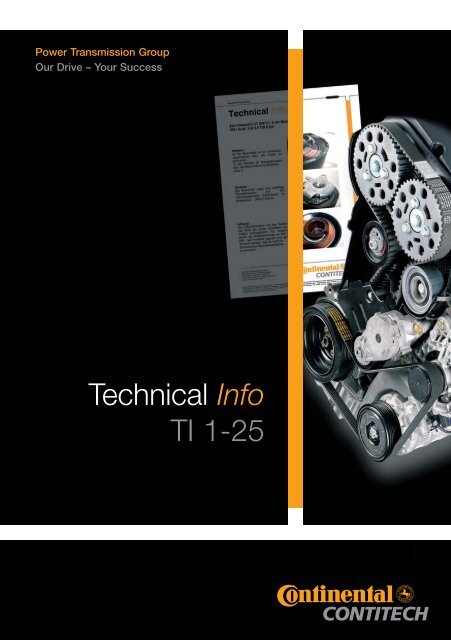
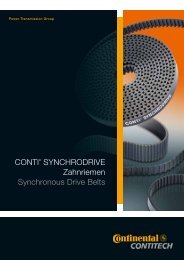
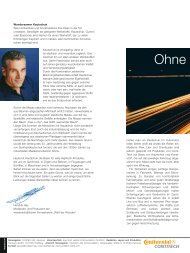
![Technical News 35/2011 [de, PDF, 256B]](https://img.yumpu.com/22013086/1/184x260/technical-news-35-2011-de-pdf-256b.jpg?quality=85)

